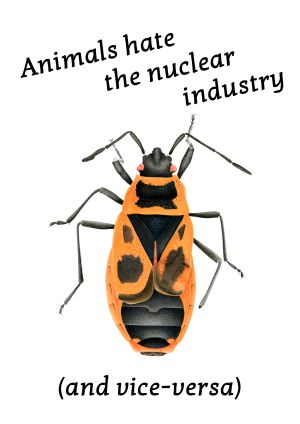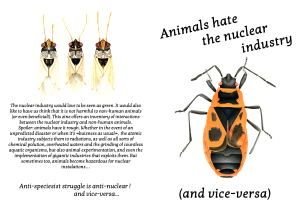To contact us or send us feedback: souslaplage@riseup.net
You can find the zine and many others on <infokiosques.net>.
souslaplage
Animals hate the nuclear industry
(and vice-versa)
1) Of animals and nucleocrates (Or the story of bad propaganda)
2) Animals suffer from nuclear power
Effects of radiation on bodies
Field studies in Chernobyl and Fukushima
When non-human animals spread radioactivity from power stations...
Discharge into water and destruction of aquatic ecosystems
Millions of fish crushed by cooling circuits
Cooling circuits absorb many other aquatic species
3) Nuclear power exploits non-human animals
Nuclear power gives rise to titanic animal exploitation projects
An industry that makes massive use of sordid animal experiments
Introduction
We have found that pro-nuclear people like to use flawed arguments about non-human animals to explain why nuclear use is not dangerous to health. In doing so, they benefit from the silence that exists about the suffering and morbidity caused by the nuclear industry on non-human animals. We have therefore tried to identify different impacts of nuclear power on animal life.
The sources we consulted were often interested in the health of non-human animals in reference to that of humans: because studying the impacts of radiation on animals provides a better understanding of its effects on humans, or because irradiation of non-human animals and plants is a potential source of contamination for humans. But the purpose of this text is to focus on the consequences on non-human animals. Animal suffering is more than enough reason for us to revolt against nuclear power and its world. We do not accept the Western ideology that we call speciesism and which places the white human being above other animal species, giving him the right to exploit, torture and kill any non-human individual, or to grab and destroy territories for the profit of capitalists without any consideration for the forms of life that depend on them. The nuclear industry fits completely into this speciesist ideology. It has no ethics, and its benefits are almost unlimited both in terms of their extent in time and space and in their magnitude.
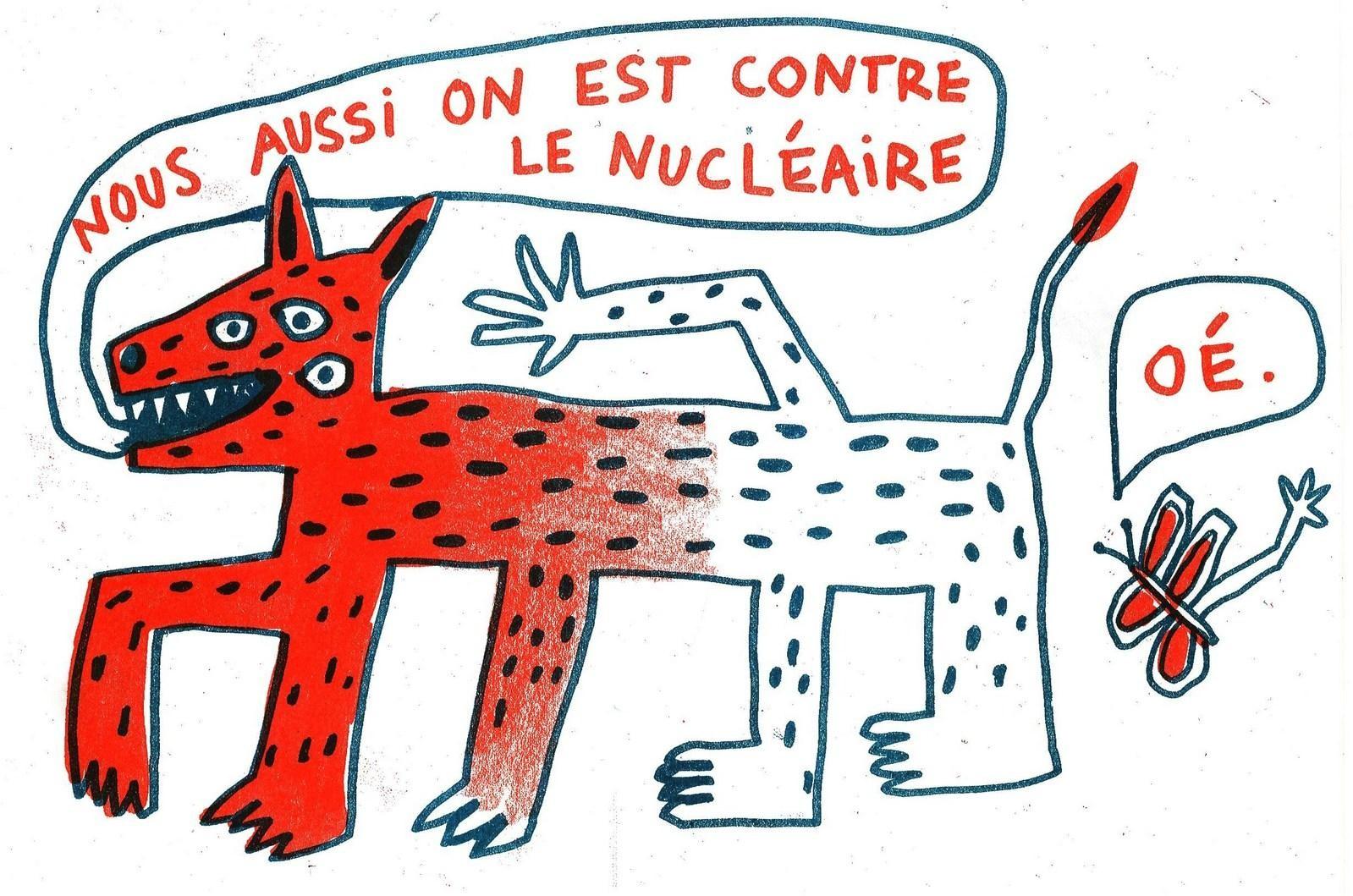
While doing research on nuclear power, we come across a lot of information that is disseminated by communicators who have financial interests in it. The nuclear lobbies have big budgets: the International Atomic Energy Agency (IAEA) has more than 500 million euros for its mission to promote the development of civil nuclear power. The UN and the World Health Organization (WHO) are affiliated with it, giving it disproportionate economic and political power.
Radioactivity is odourless and invisible. Nuclear power is a very technical subject. All the components are brought together for the monopolization of the understanding of this subject by scientists and elites who will know how to select the information to guide the opinion. For example, there is a multiplicity of radioactive elements, and sometimes it is enough to study this element rather than another, or to take a measurement at this or that place, or to change the scale of the research to obtain a conclusion that suits a certain vision.
When we give examples of individuals who have suffered the consequences of radiation, nucleocrats highlight other individuals who have fared better[1] or retort that the case is marginal and that we must look at on a larger scale according to criteria that suit them.[2] This stratagem quickly dispossessed us of the subject in favor of expertise, counter-expertise and counter-counter-expertise. Figures are always posed as fundamentally objective, yet on such a subject there seem to be as many figures as opinions. Thus, for Chernobyl the range of the number of deaths goes from 50 deaths to... 1 million (with other sources citing all intermediate figures).[3] Similarly, the count of people displaced by the tsunami and the Fukushima disaster ranges from 90,000 to 470,000.
For this text, we have gathered a large amount of data from scientific studies that seemed rigorous and reliable to us. Nevertheless, it is important to say that we must not be dispossessed of the nuclear subject by scientists: they are also exceeded by the subject and its magnitude. Among the difficulties which make it impossible to measure the fallout from atomic energy, we can cite a time scale which exceeds by far the understanding capacity of human being: it takes more than 200,000 years for plutonium to cease to be highly toxic — and the damage caused on the living by radioactivity spread over generations in the event of DNA alteration.
The main idea behind nuclear protection is dilution: when there is a large rain, industrialists can simply drop more radioactive compounds in water or the atmosphere. The sea, the rivers and the air are large and there is no account to be rendered on the raw quantity of radioactive compounds which are rejected there. Dying nuclear resumes in the majority of cases to die of cancer (1st cause of mortality in rich countries) or other strange diseases[4], which is most often impossible to determine the causes with certainties or if they could have been avoided . You could say the same thing about miscarriages and malformations in infants. Same for the global decrease in fertility. Nucleocrats, petrochemical manufacturers and plastic manufacturers only have to blame one another indefinitely before finding themselves all together to dinner after work. The crime is perfect: once the poison has been diluted, the victims are scattered throughout the globe and on dozens or hundreds of generations. Quantifying the consequences of nuclear energy on life is therefore a difficult and perhaps even impossible task.
If we go on to use figures and statistical studies, we need to bear in mind that this quantitative approach is not the only one possible. To claim that there were very few victims of the Chernobyl disaster is perfectly indecent (Jancovici, if I see you, I’ll bite you). But as to whether there were many or a great many, the question should not make us forget that these individuals existed and that their suffering was real, horrible and unjust.
1) Of animals and nucleocrates (Or the story of bad propaganda)
Once upon a time, Florida crocodiles had all but died out, when suddenly the construction of a nuclear power plant allowed them to proliferate once again in the warm waters discharged by the plant.
American crocodiles were on the verge of extinction, but their numbers multiplied enough to raise their federal status from “endangered” to “threatened” in 2007.
Several hundred crocodiles now inhabit the canals at Turkey Point. To ensure the continued growth and success of the crocodile population, biologists from FPL (Florida Power & Light) visit the canals each year between January and April to build nesting sites for crocodile mothers. Months later, the newborns are captured, measured and microchipped, then redistributed throughout the canal network — which spans 270 kilometers — giving the babies a better chance of survival than being released together in the same place.
Since the start of the conservation and monitoring program, “Team Croc” has tagged more than 7,000 crocodiles, FPL officials reported. In addition to microchipping newborns, scientists are also building ponds to protect the young from predators and conducting surveys to monitor the health and growth of the canal’s crocodiles.[5]
Later in the article, it is mentioned that these waters contain ammonia and tritium, and that study reports are underway to find out if this could have a harmful effect on crocs and other animals.
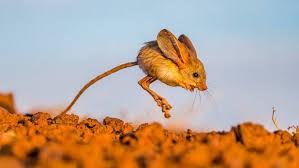
Sand rodent nicknamed mountain mouse.
It’s also the name given to the first 4 French nuclear tests between 1960 and 1961 in its Sahara colonies, called successively with great finesse: blue — white — red — green.
But even so, one gets the impression that nuclear power and animals are a good match after all, and that nuclear scientists have plenty of energy to put into research for the well-being of non-human animals.
In fact, if you do a search on the key words “nuclear and animals”, one of the first results you find is the IAEA (International Atomic Energy Agency) page, which explains that the nuclear industry is designed to help breeders (and especially small breeders!) in dominated countries by enabling them to maximize their production.[6]
When the nuclear industry gets the chance, it doesn’t hesitate to boast about its “beneficial” relationship with animals. And when it comes to self-congratulation, curiously enough, the financial means exist to produce absurd research.[7] Nevertheless, when it comes to finding out the real consequences of radiation on non-human animals, we have to dig deep and, above all, make do with relatively little.
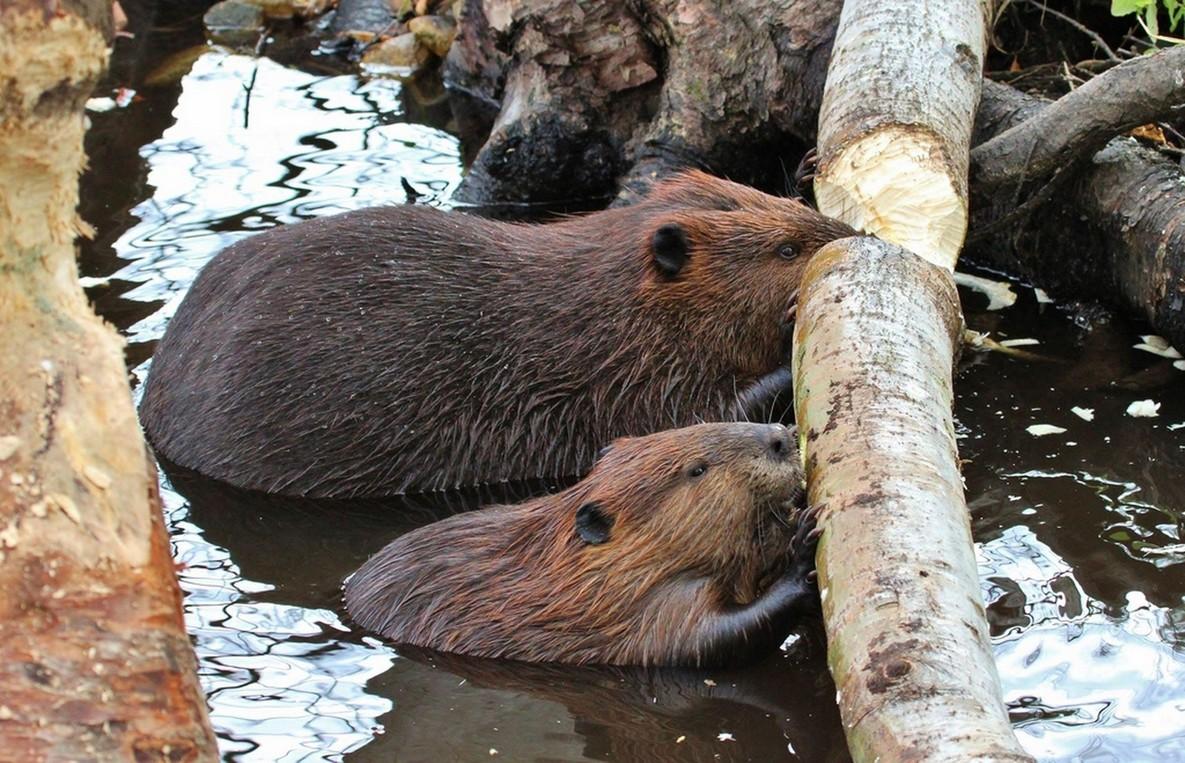
-
Trademark registered by a German company for “Cask for storage and transport of radioactive material”: Name of a packaging designed for the transport and storage of nuclear fuel or waste.
-
French nuclear test of a 450,000-ton nuclear bomb at Moruroa in July 1968. Name chosen in reference to the constellation.
While stating that few studies exist, IRSN does not hesitate in its 2012 document “Decision-support guide for managing the agricultural environment in the event of a nuclear accident”[8] to assert that all non-human animals are super-beings that do not suffer the consequences that can affect humans. A paragraph on this subject in a 100-page report:
“Consequences for animals
Fatal and non-fatal effects on animals are only observed at very high exposures. In animals, lethal doses vary according to species. Such exposures could only result from a major accident and in the area close to the accident site, i.e. in circumstances where the problems posed to the population would be overwhelmingly dominant“.[9]
This information is misleading: we know that humans are affected by low doses[10], and the same is true for most species. A glaring example of this is the insistence that Chernobyl has become a nature reserve.
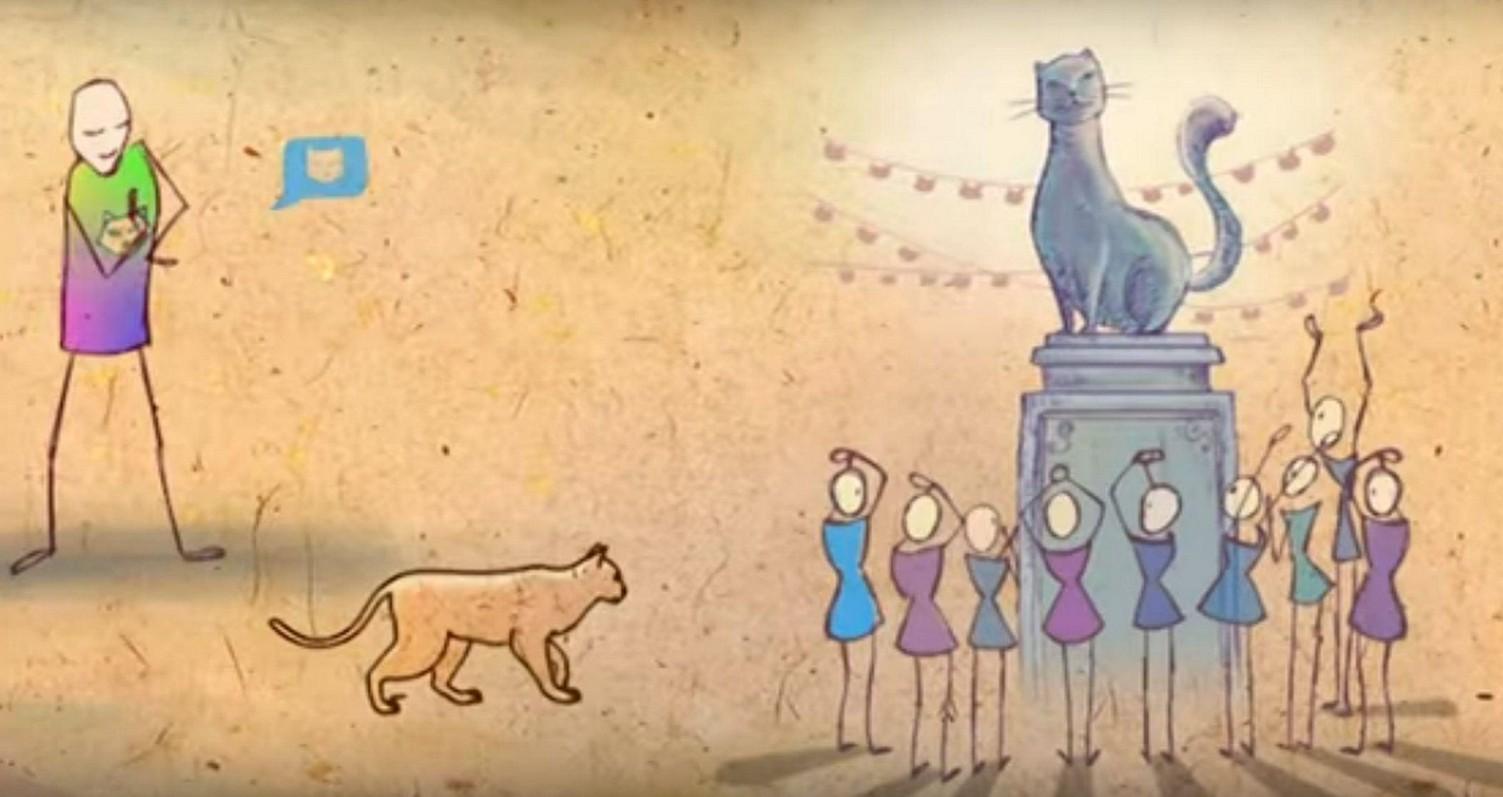
It is a response to an annual call for artists by Andra (National Radioactive Waste Management Agency[11]) to make the Cigeo nuclear waste project acceptable. The video, which won the Andra prize in 2015, proposes a solution so that generations several thousand years from now will know that there is highly radioactive waste 500m below the surface.
The idea is to genetically modify cats to turn them into Geiger counters: in contact with radioactivity, these cats will become fluorescent. At the same time, a “cat cult” is to be created, which will transmit the message for hundreds of generations to come that fluorescent cats signal a danger that must be avoided at all costs.[12]
Admittedly, there are more large non-human animals in Chernobyl now than before the disaster, including wolves, wild boar and even takhis, horses native to the Mongolian steppes that have almost entirely disappeared.
On the subject, among youtube’s star videos, there is a tearful documentary on Chernobyl’s stray dogs, who are not necessarily in poor health and are taken in, sterilized, shampooed to lower their radioactivity levels and then sent to the United States for adoption. And then there’s that famous video of a fox making himself a sandwich, viewed and relayed countless times.
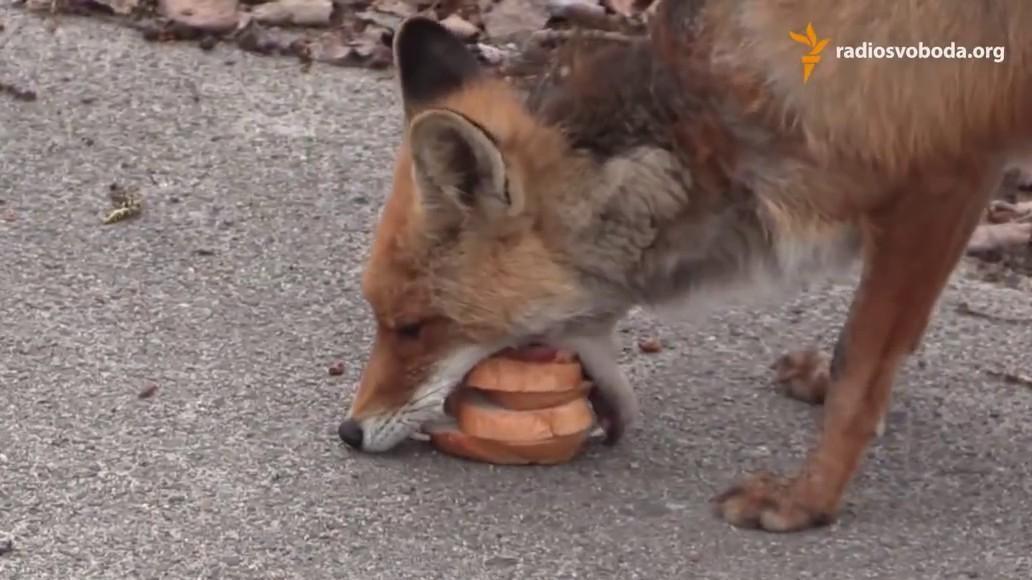
The message is clear: EVERYTHING IS GOING WELL.
Here are a few examples from pro-nuclear sources. On Futura Science in the January 2020 article In Fukushima, as in Chernobyl, the exclusion zone becomes a refuge for wild animals[13]:
“Raccoons, for example, which are nocturnal animals, are always more active at night, while pheasants, which are diurnal birds, are always more active during the day”, says the study (...)
However, the researchers did not analyze the biological consequences of radiation on the animals.
Previous studies have noted deleterious mutations in wild boar, butterflies, swallows and earthworms, as well as reproductive problems in goshawks. “But our study shows that these consequences at the individual level do not seem to manifest themselves on animals in terms of abundance and behavior,” note the authors.”
The same article mentions 106 cameras installed by the University of Georgia. And in the article “Ces animaux sauvages qui peuplent les zones radioactives évacuées de Fukushima” (“These wild animals that populate the radioactive areas evacuated from Fukushima”) published in Science et Avenir in January 2020, we are told that “267,000 photos attest to the revival of post-disaster biodiversity”.
So yes, the photos don’t show any 5-legged animals, or radioactivity. You don’t see non-human animals having miscarriages or simply being sterile. We don’t see them dying of mild illnesses because their white blood cell count is too low.
This apparent abundance tells us nothing about the consequences of high levels of radioactivity on these individuals. In fact, to say that the disaster benefited the animals because there are more of them now than before the disaster, would be the same as saying that it benefited the poor because it lowered rents in the region.
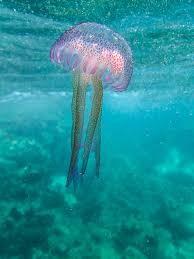
The term “jellyfish baby” is used to refer to babies born without limbs as a result of French nuclear testing in Polynesia.
“As described by Mrs Darlene Keju-Johnson, director of family planning in the Marshall Islands from 1987 to 1992: “The babies have no eyes; no head; no arms; no legs. They don’t have the shape of a human being. They are baby jellyfish. Their exact number remains unknown, but it is estimated at over a hundred.““[14]
These observations only indicate that Western human activity is harming other animal species. Rather than concluding from them that nuclear accidents are beneficial, they should encourage us to fight against hunting, against the over-exploitation of land and for the de-urbanization and re-establishment of large wilderness areas.
While the departure of humans has had positive consequences for wildlife, radiation remains toxic and its effects relatively unknown and curiously little studied.
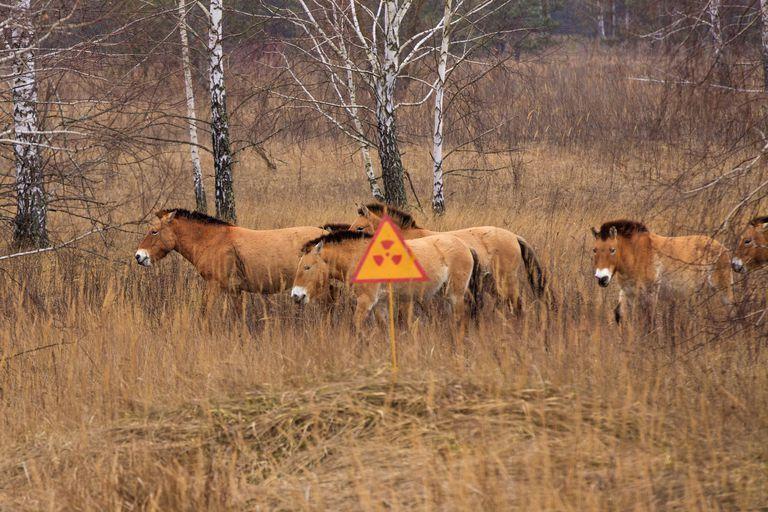
By the 1950s, Mongolia’s wild Przewalski’s horses (named after the settler who “discovered” them), better known as takhis, had completely disappeared in the wild.[15] From the 11 survivors “preserved” in zoos, it was possible to “reintroduce” them to the steppes of Mongolia in the 2000s, but also in 1990... at Chernobyl. Thirty-one relatively unhealthy individuals from a Ukrainian breeding farm have been released in the exclusion zone, for reasons that are unclear: vague kinship with a wild horse that may have lived there in the distant past, scientific experimentation, or simply because the breeding farm wanted to get rid of them?[16] If their population initially fell, the latest counting operations estimate that there are now 150 of them. Takhis have become one of the mascots of the irradiated zone, and are constantly in the news. Among the various tours organized in Chernobyl for tourists and other survivalists in search of thrills, most highlight the possibility of meeting takhis in their advertising.
In Fukushima, a few wild boars that have reproduced with the pigs are making headlines in all the media: “Radiation has not caused genetic changes in animals, but the invasion of domestic pigs has“[17], “Fukushima: ten years after the disaster, nature is reclaiming its rights”, “Fukushima: invasion of radioactive wild boars“[18]
2) Animals suffer from nuclear power
Nuclear pollution is on a global scale, but its concentration varies enormously from place to place. From the bombings of the last century to the equally toxic nuclear tests that accompanied them, from the extraction and enrichment of radioactive fuels to the storage of waste, the nuclear industry contaminates every place it sets up shop. At a time when Macron’s government is announcing a revival of the nuclear industry, we think it would be interesting to ask what has happened to the animals that have suffered the disasters generated by this industry, notably the cases of Chernobyl in 1986 and Fukushima in 2011.
In the event of disaster, no plan to save the animals (Or how to leave non-priority animals to die in the open air.)
The nuclear sector is one of those fields where there is no insurance cover in the event of an accident. It’s up to the State to take charge of emergency measures, which for the most serious accidents can cost between tens and hundreds of billions of euros in population displacement, health care and economic compensation — if the State takes responsibility at all. In the case of Fukushima, between 100,000 and 400,000 people were displaced.
No provision has been made for domestic, farmed or wild animals, and the immediate repercussions of nuclear accidents are dramatic:
-
With the displacement of populations, all animals dependent on humans are abandoned on the spot, often tied up or locked up, without sufficient food or water.
-
Mass slaughter order. In Chernobyl, all animals within 1 km² were slaughtered by liquidators to prevent contamination.
In Fukushima, Japan, the Prime Minister ordered the slaughter of all livestock. It is estimated that almost a million animals died as a result of slaughter or abandonment.
Naoto Matsumura, who returned to live in Fukushima shortly after the accident to look after the animals, recounts his helplessness in the face of the suffering of cattle trapped in stables and howling with hunger. In the wake of their mass deaths, he describes an unbearable smell, a deafening roar of flies and images of mass graves that look like something out of hell.
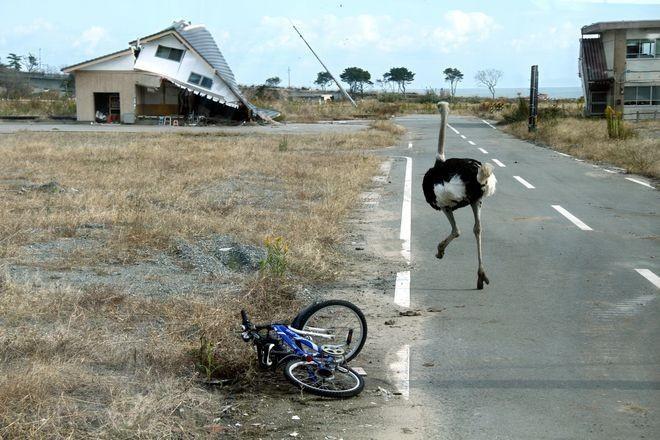
What are African birds doing in the streets of Fukushima?
In 1999, the nuclear power plant decided to adopt 4 ostriches as mascots. Ostriches as a symbol of nuclear power was an idea that anti-nuclear people had already had. But this time the reasoning doesn’t come from “sticking your head in the sand”. Rather, TEPCO’s (Tokyo Electric Power Co.) choice is based on the fact that these birds grow fast and produce very large eggs in relation to the amount of food they need. This productivist logic led them to make a very bad choice: ostriches are not “pets”, and keeping them at the power station proved to be a headache. Two years later, the three survivors were entrusted to a certain Tomizawa, who acquired others and opened an ostrich farm for tourists near the power plant. By the time of the disaster in 2011, there were 30 of them. Half of them died of starvation in the immediate aftermath, and the other half were released following media coverage.[19] With the exception of two who were taken in by Naoto Matsumura, they wandered the abandoned streets until the government ordered their recapture and slaughter.[20]
The same would apply to France. The 2007 “Decision-support guide for managing the agricultural environment in the event of a nuclear accident”[21] from the French Ministry of Agriculture and a whole host of nuclear authorities recommends that livestock be slaughtered from areas affected by population displacement. In their vocabulary, this means:
“CASE 1: If the sheltering of the population is maintained or if evacuation is decided, measures must be taken rapidly (< 24 — 48 h) regarding the fate of the animals. The animals cannot be used for food. The aim in this zone is to limit operator exposure and the immediate consequences of waste management. Two options are available:
Rapid destruction of the animals and burial of the corpses in the area. However, this option has far-reaching consequences and is difficult to implement.
Keeping the animals alive until the carcasses can be disposed of.
This option translates into the distribution of feed, even contaminated feed, and water to the animals. For livestock rearing in buildings, feed and water supply is usually automated. Nevertheless, routine husbandry tasks require permanent access to the farm by an operator. For technical reasons, animals cannot be moved.”[22]
The link quoted above is an archive of a page that is no longer present on the government website. This report was frightening at the time.[23]
This nuclear accident management guide has been replaced by a “2012 version“[24] with exactly the same name, but with a lot of added language: 60% of the text argues at length about why we are essentially confronted with natural radioactivity, or goes on at length about what is the agricultural sector in France (not much to do with the original title of the document). IRSN justifies the changes between the 2 reports as follows: “to revise the strategic options in the light of feedback from use of the guide“.[25]
In the 2012 document, the only mention of animal disposal is in euphemism: “The main consequence of the systematic bans on consumption and placing on the market is that all these products are to be managed as “contaminated” waste and in a specific way, following the instructions laid down by the public authorities”. While the words “destroy animals” and “disposal” no longer appear, the word “animal welfare” has been added. In reality, what ensures that in times of crisis, animals are always left in the most squalid conditions is the economic issue. The aim of animal husbandry is to generate value, not “kindness”. In the 1st report it is explained about the cost of “animal destruction” (parts deleted from the 2012 report):
“The cost of destroying livestock can be assessed when the implementation methods are defined by the state services. For information, the cost of destroying 64 heifers infected with bluetongue (2006) was evaluated at €200,000 (euthanasia, transport, incineration and purchase of heifers from the producer).”
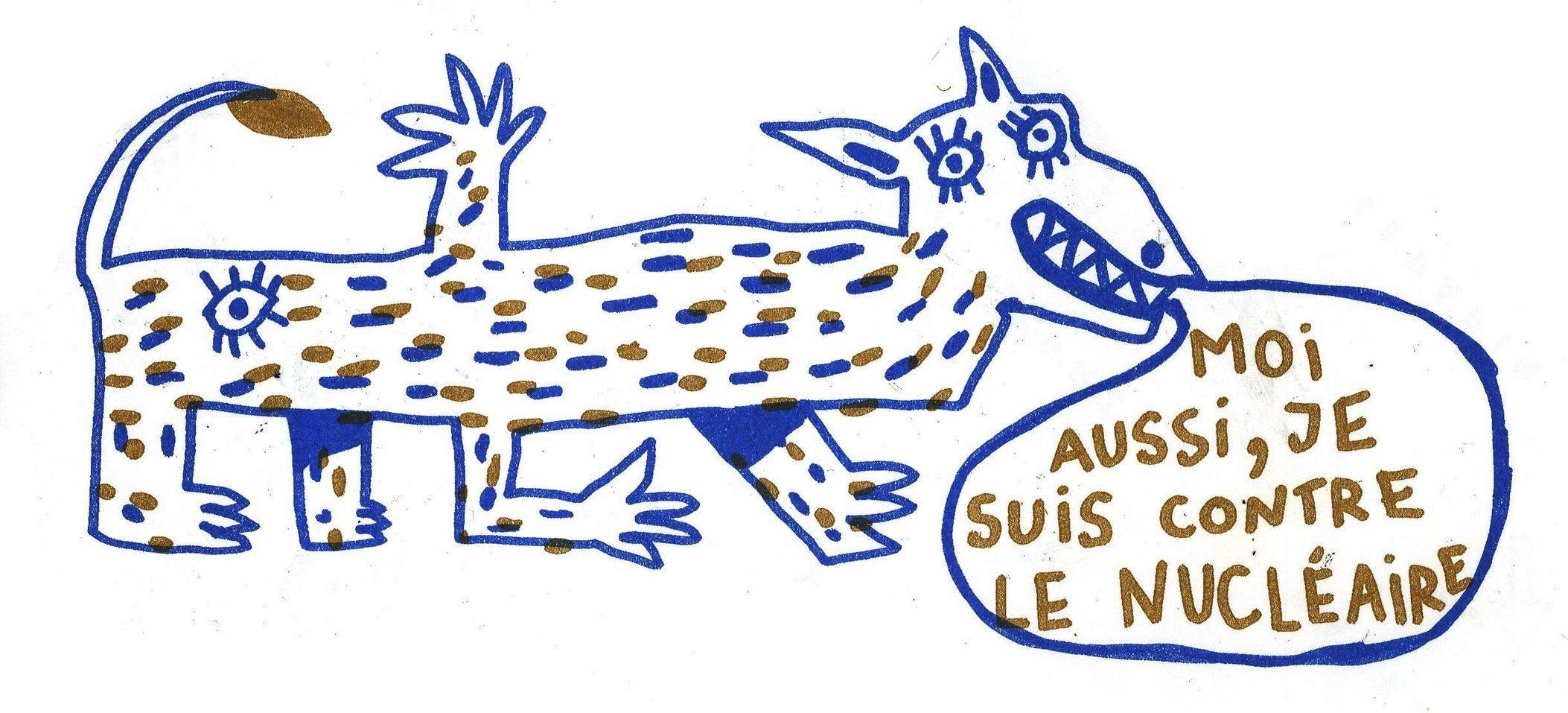
Effects of radiation on bodies
Let’s not forget that even when it comes to the effects of the disaster on human beings, the information leaves much to be desired. The figures put forward for the number of deaths or displaced persons vary widely depending on who is producing them, with pro-nuclear states and institutions with their scientific-economical-media arsenal on one side, and more or less independent journalists or laboratories on the other.
On the Wikipedia page on the Chernobyl disaster, we learn that “The IAEA [International Atomic Energy Agency] estimates that there is no statistically observable effect on the rate of leukemia or cancer (other than thyroid cancer) in the most exposed populations”.
And also that “For the WHO, the main cause of death due to the Chernobyl disaster is stress, not radiation. However, it should be remembered that the WHO, a UN organization, has been bound since 1959 by its statutes to the IAEA, which prohibits it from ‘undertaking any program or activity’ in the nuclear field without consulting the latter ‘with a view to settling the matter by mutual agreement’ (point 2 of article 1)”.
Under these conditions, it’s hardly surprising that it’s difficult to find relevant information on the state of health of non-human animals in the Fukushima and Chernobyl areas.
Here we return to the oft-repeated mantra that it’s not radiation that’s dangerous, but radiophobia — in other words, the fear of radiation: non-human animals don’t smell or see radiation, they’re not afraid of it. And yet...
In the film “Bon baiser de Moruroa”, we are told what happens when radioactivity comes into contact with a body:
“Radioactivity is carried by particles, by elements, i.e. these particles are in the air and we breathe them in, a 2nd entry is through the ingestion of food and drink, and the 3rd is penetration through the skin.
Of course, the vast majority of radioactive products that enter the human body will leave it. [But some of them, and this is where the danger lies, will remain in the human body. And each has a particular place where it will go. Strontium, which resembles calcium, goes directly to the bones, iodine to the thyroid, caesium to the liver. All it takes is small, regular, chronic doses taken, for example, with strontium-polluted drinks, for the product to gradually accumulate in the bones, with all its consequences.”
The same film explains that radioactivity can create “recessive” mutations. Some mutations are said to be “dominant”, meaning that the mutation is expressed as soon as the mutated gene is present. In the case of a “recessive” mutation, an individual may be a carrier of an abnormal gene without suffering any consequences, but if he or she reproduces with another individual who has an abnormality in the same gene, the abnormal gene may be expressed in their offspring. This means that certain mutations can take several generations to express themselves. Still from the same film:
“In the aftermath of Chernobyl, studies carried out in Belarus show that the negative effects of this genetic instability system on small forest animals increase up to the 22nd generation”.
Field studies in Chernobyl and Fukushima
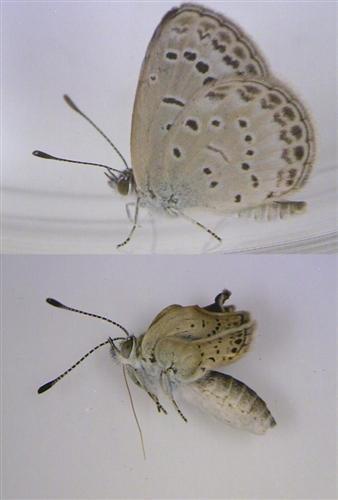
These phenomena were also observed by Joji Otaki in his study of irradiated butterflies from Fukushima, more specifically Zizeeria maha. This small blue butterfly has already been the subject of extensive studies on the effects of transgenic corn on insects. Scientists therefore have a wealth of data on the butterfly and its reproductive cycles. At the time of the Fukushima Daichi power plant explosion, it was winter and the Z.Maha were small larvae. Individuals collected 2 months later showed 12.4% morphological abnormalities, particularly in wing and eye shape. But this percentage and the variety of malformations increase as these butterflies reproduce: the next generation, reproduced in a laboratory far from Fukushima, shows 18.5% anomalies, and these extend to the legs, antennae, abdomen and proboscis. Butterflies collected 6 months later around the plant showed 28.1% abnormalities, and the next generation 59.1%. The two elements combine: irradiation affects the genome, which is transmitted in a worsening fashion — and the longer you spend in an irradiated environment, the more deformities you develop.[26]
Joji Otaki says these results are surprising, given that insects are reputed to be rather resistant to radiation.[27]
The explanation may lie in this hypothesis put forward in an article about Chernobyl:
“In particular, invertebrate populations (including bees, butterflies, spiders, grasshoppers and dragonflies) have declined. This is probably due to the fact that animals lay their eggs in the top layer of soil, which contains high levels of radioactivity.
Radionuclides present in the water have been deposited in lake sediments. Aquatic organisms are contaminated and face permanent genetic instability. Species affected include frogs, fish, crustaceans and insect larvae.“[28]
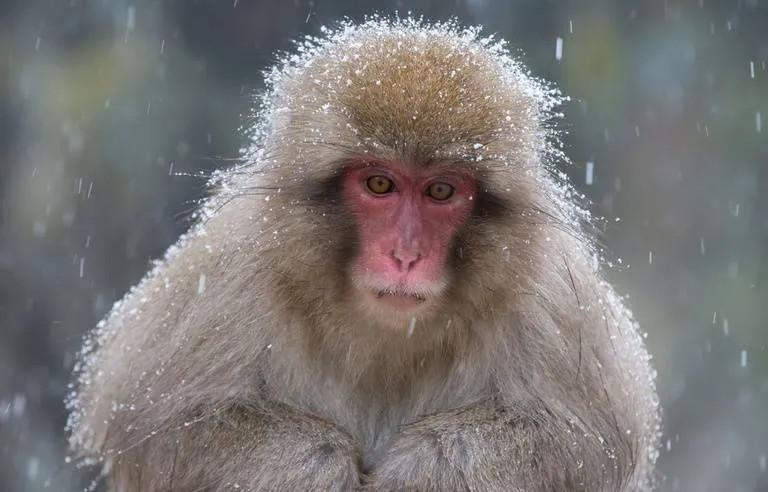
Dr. Shin-ichi Hayama’s study focuses on **macaques in Fukushima*. He has been studying them since 2008, so his data enable a very precise comparison of the effects of the disaster that occurred in March 2011. It shows that macaques with the highest levels of caesium, and therefore radiation exposure, are smaller, with smaller heads and brains, and less white blood cells, red blood cells and haemoglobin in their spinal cords and blood. They are therefore less healthy overall. The study continued until at least 2017, without any improvement in the situation being observed.[29]
Finally, the studies carried out by Möller and Mousseau in the Chernobyl area completely disprove the idea of Chernobyl as a nature reserve.[30] In particular, they found that swallows in the area are in a pitiful state of health, with deficiencies and smaller brains, as well as a particularly high sterility rate in both males and females:
“Like people whose cancer is treated with radiotherapy, most birds have deformed spermatozoa. In the worst-affected areas, almost 40% of male birds are totally sterile, possessing no sperm or only sperm that died during the breeding season. Tumors, most likely cancerous, can be observed in birds present in the most irradiated areas.“[31]
Counting and bagging operations have shown that statistically very few swallows return from migration. However, nests left empty continue to attract new swallows, who settle in the area and are in turn contaminated.
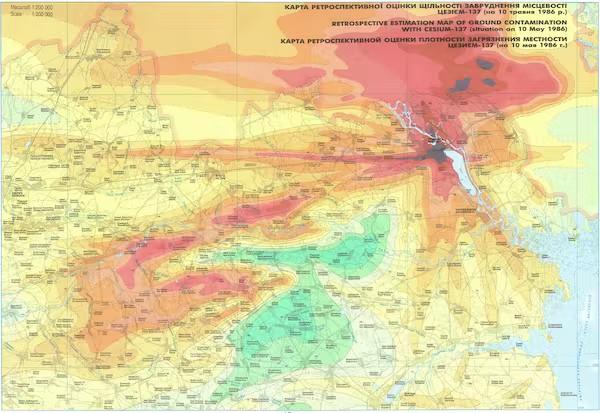
It’s also important to understand that within the huge Chernobyl exclusion zone, radiation levels vary enormously, and while some less-affected areas may provide refuges for wildlife, others are uninhabitable.[32]
“In the most radioactive areas, they can’t even catch mice, because there aren’t any,” says Kate Brown. There are also very few pollinators, so very little fruit and fruit-eating animals like birds. The bird population has fallen by 66% in these areas, and those that do live there often suffer from deformities. Dead leaves and trees don’t decompose, because there aren’t enough insects and microbes to take care of them.“[33]
Plants can also be severely affected, depending on the species. At Chernobyl, for example, all conifers died in the “lethal zone” (4 km2), which suffered the highest degree of contamination (an area known as the “red forest” because of the color of the dead trees). In the “sublethal zone” (38 km2), a few individual trees or most growing points died. In the “medium damage zone” (120 km2), conifer morphology was affected, and conifers were unable to reproduce, while even in the “minor damage zone” they showed disturbances to growth, reproduction and morphology.[34]
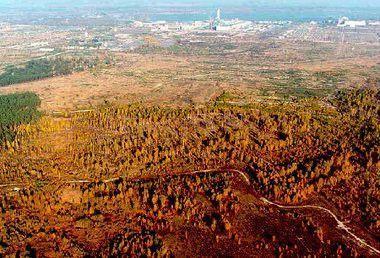
To complete the discussion of the consequences of the Chernobyl disaster, here is an excerpt from an article amply sourced by the studies of Möller and Mousseau:
“Behind the abundance and density of species lie deleterious effects on a molecular scale. Ionizing radiation can act directly on DNA, inducing genetic mutations. It can also damage cells through so-called oxidative stress. As a result, blood count anomalies and histological alterations of the spleen and liver, as well as of the endocrine system, have been observed in micro-mammals. A high rate of morphological abnormalities (partial albinism, beak malformations, tumors) has been observed in swallows, along with a decline in their survival (2). In addition, bird populations (546 individuals of 48 species sampled) showed significantly smaller brains than in control areas (3), and an increase in cataracts with increasing radiation levels (57 species sampled) (4). A study also shows that grasshopper offspring show abnormalities in development, survival and reproductive success (5). Finally, a radioactivity-induced loss of immunity has been observed among plants and animals, through the occurrence of numerous infectious diseases (6). These negative effects are mainly detected at individual level, but these alterations do not seem to affect the maintenance of populations. A case in point is the raccoon dog killed in its (highly contaminated) burrow for analysis: it had a dose of radioactivity lethal to humans! Similarly, one study showed an adaptive reaction in frogs through a change in coloration. Frogs living in the exclusion zone are darker, which could protect them from radiation because certain pigments help combat oxidative stress.“[35]
Similar findings were made for farm animals following the Chernobyl disaster:
“Breeders noticed an increase in genetic abnormalities in farm animals immediately after the Chernobyl accident. In 1989 and 1990, the number of deformities increased again, perhaps due to the radiation emitted by the sarcophagus designed to isolate the nuclear core. In 1990, around 400 deformed animals were born. Most of the deformities were so severe that the animals lived only a few hours.
Examples of defects included facial malformations, extra appendages, abnormal coloration and reduced size. Mutations in domestic animals were most common in cattle and pigs. In addition, cows exposed to fallout and fed radioactive feed produced radioactive milk.“[36]
Finally, it’s worth remembering that the consequences of nuclear disasters are far from confined to a defined geographical area (just as clouds don’t stop at borders). On the contrary, they persist and spread over large territories via wind, sea currents and absorption into the food chain. Plankton, seaweed, mussels, sea urchins, clams, oysters and seabed sediments all concentrate certain radioactive elements. Some fish caught in Fukushima prefecture have been found to contain up to 7,400 times the Japanese radioactive standard (established following the accident).[37]
We also know that Chernobyl-related caesium 137 — 30 years later — has been found in wild boar all over Europe.
“Every year, Germany pays out almost 500,000 euros in compensation to hunters who are unable to sell or eat their game when the level exceeds 600 becquerels per kg“.[38]
What’s more, since radioactivity impacts DNA, animals moving around and reproducing can potentially spread these altered genetics throughout the species.
Uranium mining kills
There is no need to wait for a “nuclear accident” to lead to a “nuclear disaster”. Nuclear power is a disaster in itself. The reality of the consequences of nuclear power on the bodies of human and non-human animals can be seen in all the testimonies of those whose lives have been touched by nuclear power, whether in uranium mines, nuclear testing, power stations or waste storage. For example, in the interview with Amina Weira, who made the film “La colère dans le vent” (Anger in the Wind) about Areva’s uranium mining in the town of Arlit in Niger:
“In the film, a woman says that her goats are dying. She was my nanny when I was a child. She had around thirty goats at the time. When I went back to her house, I expected her to tell me that she had sold her goats. But she told me that they had had a strange illness. Around Arlit, you don’t see any fennecs or antelopes any more... This lady lives in a house built from [uranium] mine fill.“[39]
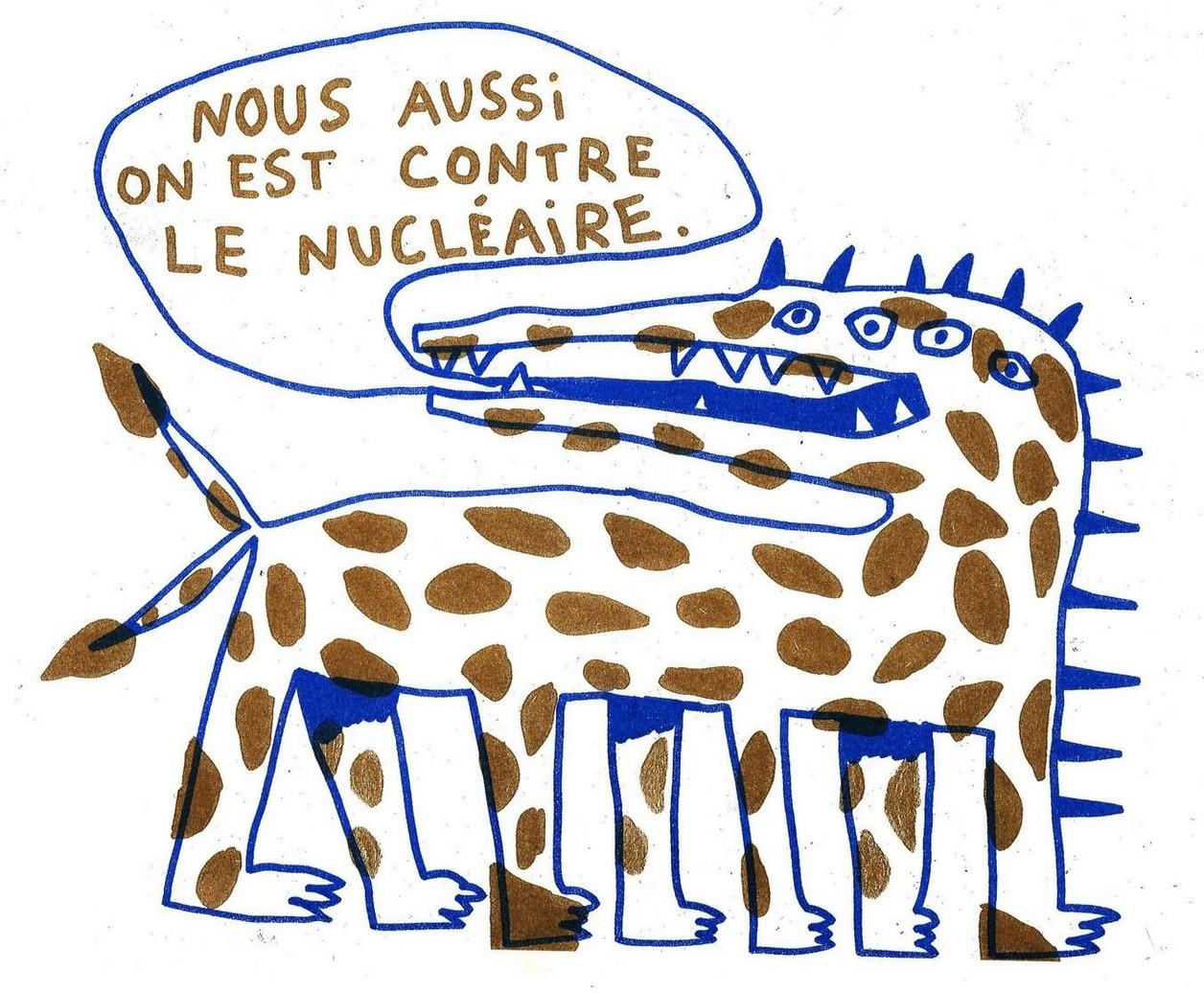
When non-human animals spread radioactivity from power stations...
If we go to Hanford in the United States, we find the dubious combination of a natural reserve and radioactivity. It was at Hanford that the plutonium used to bomb Nagasaki and many other nuclear tests was enriched. The manufacture of weapons-grade plutonium is particularly disgusting in terms of the production of high-level waste, and the Hanford site, now inactive, is the largest nuclear waste dump in the USA. Dismantling it is an even bigger job than building it: around 2 billion dollars a year, with already 43 million m3 of radioactive waste and 130 million m3 of contaminated soil and debris recovered, some of it stored in leaking tanks [40]. And this site is located between two nature reserves. While the region’s ecosystems have succumbed to the agri-food industry, the Saddle Mountain reserve remains wild because it cannot be farmed due to its proximity to Hanford.
Around 2010, a radioactive hare was captured on the base. It was shot and its body treated as nuclear waste. It seems that the 1969 barrier system had not taken into account the possibility of passing underneath. Apparently, the story began with a badger digging its burrow down to the radioactive sludge dump. As we know, badger burrows are used by many species and this mud, now accessible, turned out to be deliciously salty for Californian hares. Following the discovery of this first radioactive hare, it was discovered that they were proliferating on the site and that their droppings, spread over acres of land, were also radioactive. Site employees are therefore tasked with finding and collecting all the hare droppings in the area. They have also reinforced the fencing and destroyed all the vegetation around the perimeter to avoid attracting more hares, topping it all off by spreading fox urine as a repellent.
To this fable we can add that around the same time, a thousand radioactive wasps’ nests were discovered near Hanford, requiring the excavation of 2.4 hectares of earth and vegetation to a depth of 20cm, which will be brought back to the site to be treated as low-emission waste.[41]
So non-human animals are not just victims of nuclear infrastructures. They are also a flaw in the system, a factor in the spread of nuclear pollution, an infinite source of unpredictable problems for the nucleocrats who continue to pretend that everything is under control.
At Sellafield, where England’s main nuclear power station is located, twin sisters ran a pigeon sanctuary that was home to 700 birds until 1998... This cute story ended badly: the neighbours, fed up with seeing their building soiled by droppings, accused the sanctuary of being a health hazard. As it happens, the authorities realised that the birds (and their droppings) were highly radioactive, probably due to their comings and goings at the nearby power station. In all, 2,000 pigeons were slaughtered at Sellafield, including the 700 from the Singing Surf Sanctuary. The entire garden and adjacent car park were also excavated and treated as nuclear waste.[42]
Discharge into water and destruction of aquatic ecosystems
Unfortunately, radiation is not the only harm caused to animals by nuclear power. In order to operate, nuclear power plants must be constantly cooled. To do this, they depend on a river or the sea, from which they pump massive quantities of water before spitting it out. To give an idea of the scale of the problem, nuclear power stations pump out two thirds of all the water withdrawn in France. This harms flora and fauna in at least three ways. At the inlet of the plant’s cooling circuit, unbelievable numbers of non-human animals are sucked into the pipes, and at its outlet, the seas and rivers are warmed up, causing considerable thermal disruption. Finally, these discharges are not just hotter, they are also more polluted:
“In 2021, the Belleville power plant has submitted an application for authorisation to discharge up to 1,100 tonnes of nitrates annually into the Loire (i.e. the amount produced by rearing 50,000 pigs), 16 tonnes of copper, 12 tonnes of monochloramine, as well as carcinogenic substances such as nitrosomorpholine... as well as 80,000 billion Becquerels of tritium (a radioactive derivative of hydrogen)!“[43]
Such discharges are authorised on the pretext that they are highly diluted. But firstly, certain types of pollution are problematic even in small doses, and secondly, they become progressively more concentrated with discharges from other power stations or industries. It also denies the fact that dilution does not necessarily take place locally: depending on currents, flow rates or stagnation of water, higher local concentrations of products can be found, with serious consequences for aquatic organisms.
Let’s look at two elements among others:
— tritium: near the Tricastin nuclear power station (Rhones-Alpes), CRIIRAD has already highlighted the high presence of tritium in plants.[44]
ACRO has also shown this to be the case in many watercourses linked to nuclear power stations (ACRO and CRIIRAD are two independent organisations that monitor radioactivity).
“Tritium [3H] or [T] is the radioactive isotope of hydrogen [H]. As such, it can replace the hydrogen atoms that make up one of the four fundamental elements (along with carbon, nitrogen and oxygen) of organic matter, and therefore of living organisms”.
It is then explained that tritium breaks molecules, and therefore potentially breaks DNA molecules, producing chemically toxic species.
“When doses are high, the damage induced in a cell is such that it leads to the cell’s death by necrosis. When a large number of cells in a tissue or organ are affected in this way, the tissue or organ itself is seriously affected.“[45]
— Another example: chlorine. As mentioned above, non-human animals are not just victims of nuclear power, but also risk factors for the facilities. We often hear about jellyfish, which are capable of blocking the cooling circuits of power stations to the point of bringing them to a standstill[46] — the warming of the water leads to the proliferation of jellyfish, as well as algae, oysters, mussels and other small organisms that clog up the pipes and pumping systems. Such shutdowns have economic consequences, with a nuclear power station losing several million euros a day. To avoid this problem, we have learned that the Gravelines power plant produces its own chlorine on site and releases it into the water: the plant releases the equivalent of 50 tonnes of bleach a day to kill and destroy the organisms that clog the circuits.[47]
Millions of fish crushed by cooling circuits
Nuclear power plants can pump several dozen to several hundred m3 of water per second. The waste and fish that accumulate in the filters are evacuated into waste containers or automatically discharged into rivers.
In this 2003 study of two nuclear power stations in Belgium, it is explained that every week, fish captured by the pumping system are ‘sampled’ for 20 minutes, which gives the following results:
“During the 54 weeks of harvesting and sampling fish from the Tihange water intakes, 90,192 fish were caught, forming a biomass of 2,515 kg and belonging to 38 species [...]. Of these 38 species trapped on the filters of the water intakes, 5 species (sculpin, common lamprey, river lamprey, Atlantic salmon and European bitterling) were found to be threatened species on the list of fish species whose habitat must be protected in the European Community.“[48]
Let’s take a look at French nuclear power plants:
“At Blayais, the only power station in France equipped with a specific system to reduce species mortality, no less than 540 tonnes of living organisms are trapped each year. The species concerned include sardines, prawns, sprats and protected fish such as European eels and the allis shad, which are on the red list of critically endangered species.“[49]
Near the Blayais nuclear power plant:
“the endangered allis shad comes to reproduce in its birthplace. [...] At the same place, 900 kilos (or more than a thousand individuals) of Atlantic shad, a “near threatened” species according to the IUCN, are suffering the same fate [trapped in the filtering drums of the nuclear plant’s water intakes]. Added to this toll are 8.8 tonnes of Alosa of undetermined type, because they are too young. Fishing for shad has been banned in the Garonne basin since 2006, due to the decline in its population. However, hundreds of kilos of this migratory fish have been ‘harvested’ year after year for almost 40 years.“[50]
In the same extensive report from August 2020 we learn that:
“Mediapart was able to consult internal reports documenting the destruction of flora and fauna since the start of the nuclear power programme. One of these reports begins in 1979, ends in 2010 and concerns 12 power plants. The authors explain that “when the nuclear power programme was launched in the 1970s and 1980s, the phenomena of trapping and entrainment [of non-human animals — editor’s note] were considered to be a major environmental impact”. The Group’s research and development department set up monitoring programmes, particularly at the Blayais power plant. But “this research stopped in 1994 because the authorities did not ask for it”. As a result, many of the measurements are old and have not been renewed.”
It is estimated that between 1981 and 1982, the Gravelines power station (the largest in Europe) sucked up 812 tonnes of living organisms, mainly gelatinous organisms (jellyfish and ctenophora) and 52 tonnes of fish, i.e. more than 35 million individuals. In this world, we talk about fish in terms of tonnes and rarely in terms of numbers of individuals, which in itself shows a lack of consideration for them. The ratio of mass to number of individuals varies enormously depending on the season and the size of the individuals. At Penly in 1994, 129 tonnes of fish were counted for a single reactor, but one report estimates that this represents 441 million individuals.
Cooling circuits absorb many other aquatic species
We’ve already talked about Florida Power and Light’s supposed commitment to saving the crocodiles near the Turkey Point power station, but FPL is capable of going much further in hypocrisy and bad taste. The St Lucia power station, managed by FPL, is located on an important nesting site for various species of sea turtle. St Lucia is not equipped with the cooling chimneys that usually characterise nuclear power plants, so it pumps all the more water into the surrounding sea: 11 billion litres of sea water a day are sucked into St Lucia’s 3km of circuits, injuring or killing thousands of marine animals, including sea turtles but also mammals such as manatees, seals and two human divers.
All species of sea turtle are endangered. Two of the most vulnerable species are found in St Lucia’s channels: the leatherback sea turtle and Kemp’s ridley sea turtle, as well as loggerhead, olive ridley and green sea turtles. More than 4000 turtles have undergone this terrible journey in the last decade, 16000 since the power station was commissioned in 1976, many of them injured and nearly 130 killed instantly.[51]
In 2016, the National Marine Fisheries Service (NMFS) increased the number of sea turtles that FPL is allowed to catch each year from 1000 to 1143. Far from keeping a low profile, FPL intends to turn the situation to its advantage. It hires biologists, opens a sea turtle hospital, organises zoological walks to observe egg-laying, and even boasts, with photos to back it up, about each of the victims it has succeeded in treating and releasing. FPL claims that the turtles, which are dragged at full speed for 5 minutes over more than 1 km, without air, through shell-covered ducts[52], will be all the better protected afterwards because they can be captured on their way out and studied by scientists who will have plenty of time to fit them with chips or GPS tags.
Feeling sick to the stomach, we read on FPL’s website: “Our sea turtle conservation programme has been dedicated to protecting this endangered species for 30 years. Our team of biologists researches and even helps to rehabilitate sea turtles that have been injured by boats or other marine animals.“[53]
The icing on the cake is that when FPL opened a solar photovoltaic plant (a field of solar panels), they named it Loggerhead Solar Energy Center after one of the turtle species.
In 2019, the Beyond Nuclear and Turtle Island Restoration Networks took legal action against the NMFS for its criminal inaction in relation to the sea turtles killed by the FPL. The lawsuit will be dropped for lack of resources.[54]
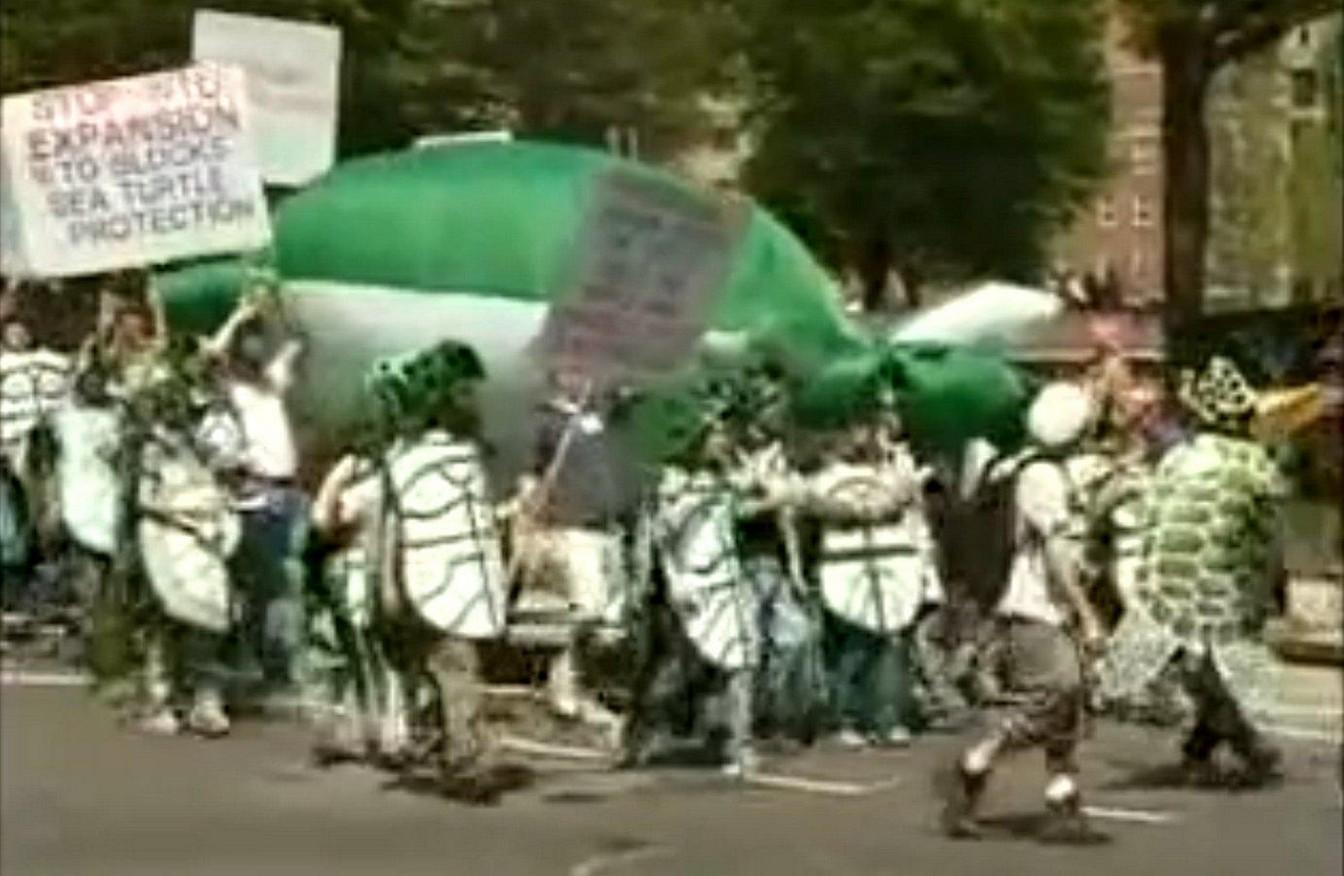
Warming rivers
Nuclear power is one of the most wasteful forms of energy. Almost 60% of the energy produced goes back into nature in the form of heat (in the atmosphere or in water). The extravagant quantities of water extracted can be released at a temperature 1 to 10 degrees higher.
“28°C is the temperature reached by the Garonne in July 2022 at the Golfech nuclear power station, a water temperature that many species have difficulty surviving. Above 25°C, most fish are already uncomfortable. Despite this, EDF was granted a derogation over the same period to discharge water with temperatures higher than the authorised thresholds! [...] Peaks of 36.5°C were observed at the Blayais nuclear power station in Gironde. [...]
The impact of these discharges can be poorly understood, as warm water does not mix immediately with cold water. In addition, measuring by the daily average can mask major variations with peaks that are harmful to flora and fauna. [...]
“This heating is of course problematic in summer, particularly affecting young fish, which are more fragile, and less mobile fauna such as molluscs, invertebrates and crustaceans, as well as aquatic plants, which cannot escape these thermal discharges. But it also has an impact outside the summer period on the migration and reproduction of fish (most species prefer temperatures below 18–20°C) and on the survival of young fish. Finally, it encourages the proliferation of invasive species and algae, accentuating the phenomenon of eutrophication.“[55]
Dependence on animal species
When we discovered that FPL also funds a ‘Manatee Lagoon’ with its annual ‘Manatee Festival’, we wanted to see what’s lying beneath the surface. We found out that FPL and other mega-industries (notably nuclear) in Florida are now essential to the survival of manatees. These placid aquatic mammals cannot survive if the water temperature falls below 18 degrees, and they have quickly incorporated the location of the nuclear power stations’ hot water outlets into their migration route (all the more so as the naturally warmer springs and pools have fallen victim to over-exploitation by humans). Manatees are generally faithful to their wintering grounds and it would appear that the young learn the routes to follow from the adults.
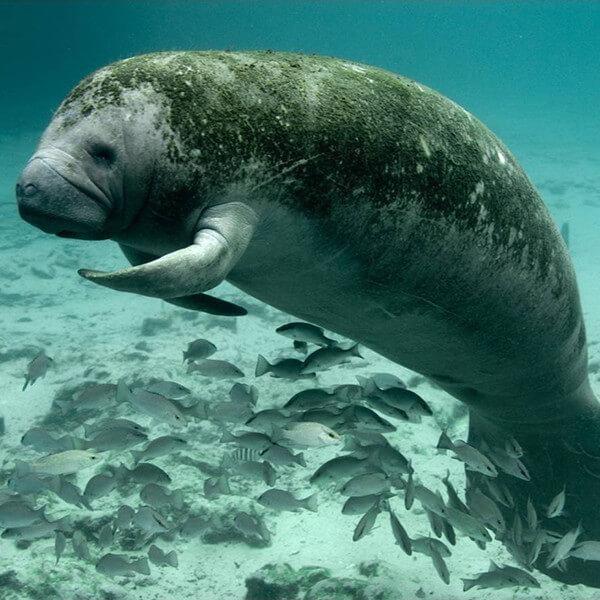
The existence of artificially warm places often prevents them from realising the drop in temperature in time, exposing them to the cold when they finally leave. Furthermore, “the manatees’ use of warm water discharges seems to be a paradox. Over time, they show a great capacity to learn to use resources such as artificial warm water refuges that did not exist historically. Moreover, they can react to the sudden elimination of these resources by simply waiting for the resources in question to reappear.“[56] And of course, sometimes the power station does not start up again, or not in time for the manatees to survive.[57]
3) Nuclear power exploits non-human animals
Nuclear power gives rise to titanic animal exploitation projects
Another reason why nuclear energy is so popular is that it allows a huge amount of energy to be concentrated in one place, making it easy for absurd energy-intensive projects to spring up. In France, having the status of an electro-intensive company, i.e. an industry that consumes a very large quantity of energy compared to its turnover, gives access to preferential energy rates and very significant tax reductions.[58]
In the 1970s, the French Atomic Energy Commission (CEA) lobbied for the reuse of some of the energy released into the environment, whether for agriculture (horticulture, market gardening) or intensive fish farming.[59]
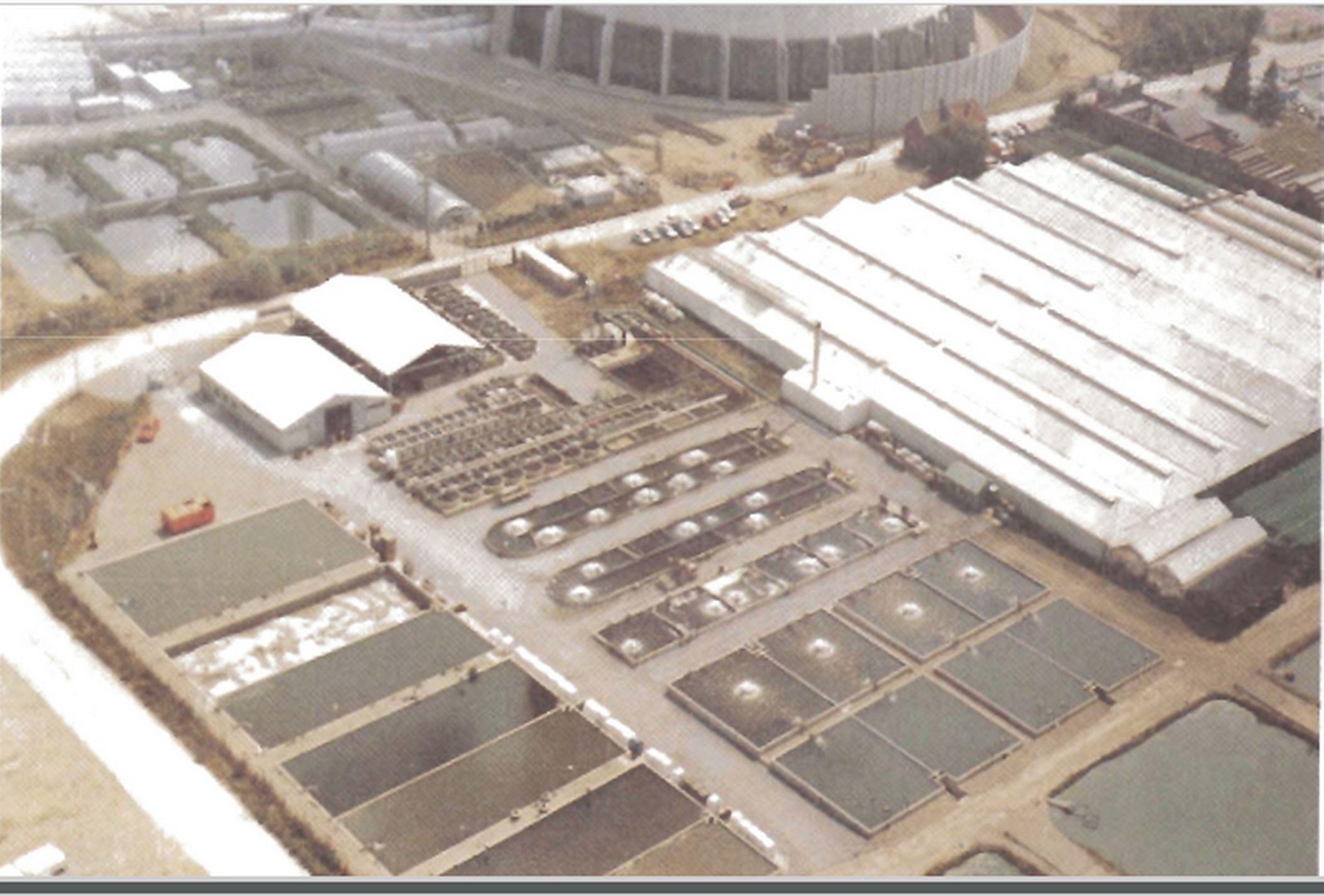
This makes otherwise unfeasible projects economically viable, radically transforming the economic and social balance around the power station and creating dependency.
As a result, one of the few industrial fish hatcheries in France was originally able to develop thanks to this access to cheap nuclear energy in Gravelines.
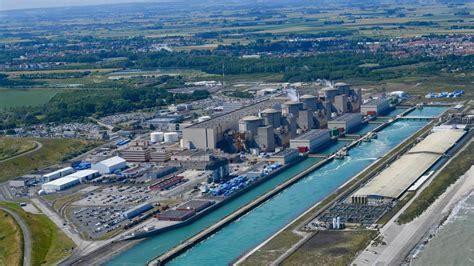
Since 1991, it has benefited from a contract with EDF allowing it to use the warm water from the power station free of charge[60] and from exemption from energy taxes until 2018 — electricity accounting for 15% of its expenditure. Aquanord, a company owned by Gloria Maris Groupe, currently processes more than 2,000 tonnes of fish a year at the site. It is the only company that raises French sea bass and sea bream on land, as well as 35 million sea bass fry (young). It is only in the last few years that it has had to pay energy tax, but it benefits from political support. Some senators are looking for ways to help it survive by changing the regulations so that it can benefit from other advantages.[61]
On a different note, there are two crocodile zoos in France that are powered by residual heat from power stations: Terre de Dragons in Civaux (opened in 2008, with 300 animals) and the Ferme aux Crocodiles in Pierrelatte (1991, with 600 animals). La Ferme aux Crocodiles is a caricature of how nuclear power, under the guise of saving energy, creates inordinate and even absurd needs. Today, all the communication about this “farm” revolves around its supposed educational or species conservation missions.[62] But a little digging reveals that the first import of 300 Nile crocodiles to Pierrelatte would have become handbags if mass tourism hadn’t become an even more profitable business than leather goods.
Living conditions for farmed fish are particularly horrific. You can read a lot about this in the text “Poissons, le carnage” (“Fish, the carnage”). Here are a few extracts from it on the subject of factory farming:
“Many fish succumb before they are “harvested”. In addition to aggression, sorting, disease and parasites, they also die from toxic algae, from excrement and urine that accumulate in the water, and from oxygen depletion in warm waters. [...]
The survivors are fattened up for two years, and the bigger they get, the tighter the space in the nets or cages becomes; imagine the equivalent of six or eight large salmon weighing three kilos spending their lives in a cubic metre of space (or a 60 cm fish living its whole life in a bathtub), whereas, free, they would migrate thousands of kilometres from the rivers where they hatched to the ocean! Trout are even more concentrated, often in tanks, at densities of 30 to 60 kg/m 3, or at worst the equivalent of twenty-seven 30 cm trout in a bathtub!
(...) Frustration is expressed by jumping and constant agitation. Mouth and fin injuries are frequent, generally caused by rubbing against nets or walls, or by collisions or aggression between fish. They are frequently fed with pellets delivered in large quantities from automatic dispensers. (...) It is estimated that it takes between 2.2 and 6 tonnes of caught fish (depending on whether it is in the form of meal, oil, etc.) to produce one tonne of farmed fish: this means countless deaths, especially as the wild fish used as food here are generally very small. [...]
Competition for food leads to aggression, fin and tail biting and even cannibalism. This phenomenon is exacerbated by the fact that some fish grow faster than others. This is why they are periodically sorted by size (the sorting takes place five times). (…)
This sorting is very stressful for them and is sometimes even carried out by a machine. The fish panic, some stop eating and lose weight, and others are injured or even die. As with all intensive farming, this leads to a high probability of disease. Stress is associated with septicaemia and skin and gill infections, while overcrowding can cause bacterial diseases or infectious pancreatic necrosis. (...) Bacterial and viral diseases can also contaminate wild populations. Fish and cages are disinfected using very aggressive products such as chlorine, and diseases are controlled using formaldehyde (!) and antibiotics, among other things.
An industry that makes massive use of sordid animal experiments
About the Hanford nuclear site in the United States:
“The carcasses of animals used in radiological experiments at Hanford are part of the more than 40,000 tonnes of waste that workers have dug up and reburied in the nuclear reserve.
Closure Hanford’s remediation manager Mark Buckmaster told the Hanford Advisory Committee last week that up to 1,000 animals at a time were being kept on a farm near Reactor F on the banks of the Columbia River. They included rodents, cats, dogs, cows, sheep, goats, pigs and alligators.“[63]
Every year in Europe, 10 million non-human animals are used, mistreated and killed in animal experiments in all sectors. Many military and civil nuclear authorities (if it is possible to distinguish between the two) use animal experiments in their laboratories.
The purpose of these nuclear studies is to develop the military and civil nuclear industry, including when it comes to establishing ‘acceptable’ concentration standards for the release of radioactive compounds into the environment. Of course, in official communications, the focus is often on the potential use of radioactivity to advance human medicine or “human knowledge”. The “exceptional discoveries” about the colour of the Eurasian jay or findings about the biology of rare fish are praised. But they lack a sensitive approach that would enable them to question their own impact on sentient beings (i.e. those who can feel pleasure and suffering). The non-human animals involved in this research are relegated to the rank of purely exploitable material, and there is never any mention of their aspirations, not even the most basic ones such as avoiding pain and fear.
“Military research is one of the areas in which animals are used as simple tools. However, the extent of this exploitation is not known, as it is very difficult to obtain information on the subject. It is known that a wide range of weapons are tested on animals: in particular AK-47 assault rifles, biological and chemical agents, and even nuclear explosions.“[64]
In 2001 there was already a campaign against the particularly horrific practices of the Commissariat de l’Énergie Atomique (CEA) towards baboons at Orsay:
“It has no windows, there is insufficient artificial lighting and the absence of a ventilation system allows neither renewal nor regulation of the temperature, contrary to the provisions of the decree. In addition, a boiler room adjoins the animal house, with no insulation, and the animals live in constant noise and heat. Lastly, the cages housing the primates are too narrow to comply with the law.“[65]
The same year in Fontenay aux Roses, a Collectif Contre l’Expérimentation et l’Exploitation Animales (CCE²A ) (Collective Against Animal Experimentation and Exploitation) fought against the CEA’s animal experimentation:
“The CEA has hundreds of animals in its basements: rats, mice, monkeys (Mauritius macaques)*... locked up in cages for years, who will never have the chance to see the light of day. In fact, for safety reasons, all these animals are slaughtered at the end of the experiments.“[66]
On the subject of the animals used in experiments at the Grenoble Synchrotron, here is the testimony of a person working there (who was fired for denouncing the practices she witnessed):
“”In most research projects, animals subjected to experiments must not lose more than 20% of their body weight. This is one of the limits that must not be crossed, otherwise the animals are euthanised. In 2015, I found that some animals had lost up to 50% of their weight, and were still alive, but in a pitiful state of course. These practices are outside the ethical charter that every laboratory or pet shop signs.”“[67]
The IRSN (Institut de Radioprotection et de Sûreté Nucléaire in France) uses a number of different non-human animals to determine how dangerous uranium is to health.
“After ingestion and absorption in the gastrointestinal tract, uranium passes into the bloodstream and accumulates mainly in the kidneys and skeleton. It is potentially both radiotoxic and chemotoxic. Its chemical toxicity is comparable to that of heavy metals. (...) Recently, animal experiments have shown that uranium can enter the brain, but very little information is available on the neurological effects of chronic low-level exposure. The aim of this study was therefore to determine whether uranium is neurotoxic after continuous ingestion of low quantities of uranium over several weeks. We used both enriched and depleted uranium to distinguish between the chemical and radiological effects of uranium.”
The document goes on to explain how scientists make rats drink water containing enriched or depleted uranium for 45 days to see how they behave afterwards. Their conclusion is cold — there is no acknowledgement of suffering.
Numerous other IRSN studies have been carried out on mice, rats, fish, dogs and tree frogs, exposing them to radon, making them drink tritium or other radioactive elements. To justify this torture, IRSN set up an “Animal Research and Ethics Support Group” (GSEA) in February 2021, to tell anyone who would listen that it takes care of animals.
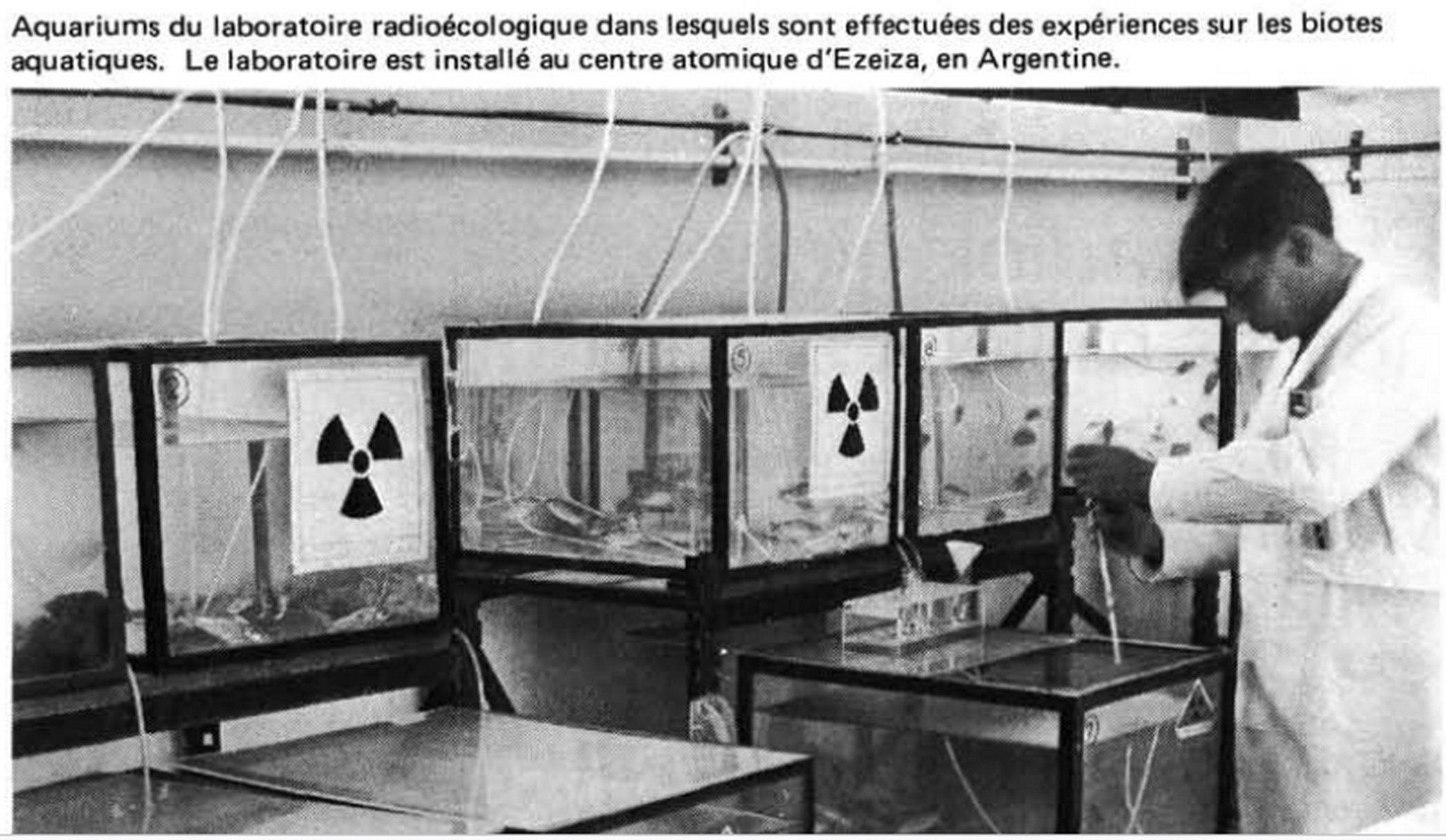
Job offers: animal torture in the land of the nucleocrats
At the CEA in December 2022:
The assistant engineer will be in charge of animal experiments as part of a research project developed by IRCM’s LRTS and LSHL laboratories, under the supervision of two senior researchers.
The candidate’s main tasks will include:
lethal or sub-lethal whole body/localised irradiation of mice
controlled administration of compounds/molecules by various routes (gavage, intravenous, subcutaneous) to prevent or treat the toxic effects of irradiation
clinical and biological monitoring (weighing, blood sampling, scoring) of treated and untreated animals, in compliance with procedures and according to pre-established specifications
animal handling (restraint, anaesthesia) and organ collection
Job offer at IRSN:
The rats will be exposed successively to acute inhalation of tungsten aerosol at low (5 mg.m-3 based on the VLEP) or high volume concentration (80 mg.m-3) and then to acute external gamma irradiation at 50 mGy (in the low dose range, <100 mGy according to UNSCEAR).
The survival and morphological integrity of neural cells as a first indicator of cerebral suffering will be assessed in the neuroanatomical complex known as the rostral migration stream, a neurogenic niche in the adult rat.
The involvement of oxidative stress will be assessed, as will that of neuroinflammation by monitoring the response of microglial cells.
Nuclear tests destroy entire ecosystems
Nuclear tests serve both as a show of force and as experiments to observe the effects of the nuclear bomb on a real scale. More than 2,400 tests have been carried out worldwide, 210 by France. These tests have had devastating consequences for the environment and animals.
Nuclear tests often take place either in the colonies (internal or external) of countries using nuclear weapons, or on their poorest territories. While governments already deny their involvement in the human health of residents or military personnel who took part in the tests, there is even less information on the non-human animals and ecosystems affected by nuclear testing. Nevertheless, here is some information on the consequences of nuclear testing in Polynesia:
“Tupou lived and worked for 4 years at Fangataufa during the first underground tests. He was team leader of a group of workers who were in charge of the drilling rigs.
“After each underground test, there was a sort of tidal wave that swept over part of Fangataufa, and a few days later, thousands of dead, stinking fish washed up on the shore.”[68]
And:
“With Canopus [a 1968 French nuclear test of the hydrogen bomb in Polynesia], mollusc species that were barely covered by water or emerged most of the time were decimated from the map of Fangataufa, until larvae returned and recolonised their habitat”, describes the biologist.
On the other hand, Canopus eradicated the vegetation and species present on Fangataufa, causing lasting disruption to the terrestrial ecosystem. “It was a problem for the vegetation itself, but also for the birds that lived in those areas and found nothing when they returned. The atoll was colonised by Aitos, also known as filaos [a fairly resistant tree], which replaced the burnt coconut palms. Fangataufa is now a very special atoll: it’s the only atoll in the world that is covered in these ironwoods,” continues the biology researcher.[69]
Another example of contaminated territory:
“The atoll of Tureia, however, has the particularity of having no pass, which means that the water in the lagoon is renewed only through a few passages communicating with the ocean (the hoas) and in heavy seas when the swell passes over the reef.
This particularity, which is not unique to the Tuamotus, was of great importance at the time of the aerial tests. The waters of the lagoon, which are little renewed, accumulated radioactivity, fallout after fallout. The entire food chain, from the coral ecosystem to fish, shellfish and humans, were progressively contaminated. What’s more, the tanks filled up with the radioactive rain often caused by condensation after a nuclear explosion.”[70]
Criticism of the studies used
A large part of the research into the effects of nuclear energy on organisms is based on the Hiroshima and Nagasaki bombings (which claimed 300,000 human lives), following which many scientists and doctors were sent by the United States not to provide treatment, but solely to study the effects of the bombs on tens of thousands of survivors of the explosions[71] — yet another appalling demonstration of the lack of ethics that characterises the nuclear authorities.
Most of the results of the studies we have cited were obtained using procedures that disgust us. To show the consequences of nuclear disasters, the studies essentially consist of killing non-human animals (the expression “taking samples” is used soberly), for example by disembowelling them to study their foetuses. Non-human animals may also be sent to certain areas to be used as Geiger counters. In Fukushima, for example, reptiles, monkeys and wild boars were sent. “The aim: to enable scientists, who fear heavy contamination of forests and waterways, to map the damage caused by the nuclear incident, without endangering human life.“[72]
There are non-lethal, even non-intrusive, counting methods and observation techniques, but very often the scientists who carry out this research, regardless of whether they are pro- or anti-nuclear, attach far more importance to efficiency than to animal welfare and dignity, resorting to breeding in laboratories, deprivation of freedom, slaughter, etc.
Take, for example, the grim irony suffered by the raccoon dog quoted above in an article that raves about its apparent immunity to radiation: immunity which didn’t do it much good, as it was killed in its burrow to satisfy human curiosity.
To conclude
“More than 400 nuclear reactors are currently in operation around the world, with 65 new ones under construction and some 165 more planned.“[73] This destructive industry, which was originally designed for the development of nuclear weapons and which continues to spread within geopolitical military frameworks, is now wearing a pretty green facade: they would have us believe that it is the solution to global warming. To say that nuclear power is a low-carbon energy source is a bad joke. From the mines to the construction of these extravagant projects, via the management of ultra-toxic waste over centuries and centuries, nuclear power produces and will continue to produce carbon dioxide in abundance. What’s more, it makes no sense to boil down ecological issues to CO2, given the many forms of pollution and destruction. Being concerned about ecology means wanting to leave healthy, suitable spaces for living species. The use of nuclear power releases many different and toxic pollutants into the environment, as well as immense quantities of heat. It can be said again and again: nuclear power will not save the climate, let alone the world. Quite the contrary, in fact.
The nucleocrats would like to give themselves a green label, but they would also like to declassify low-level radioactive waste so that it can be integrated into everyday life, or they would like to claim that they know what to do with their waste by burying it in Bure or elsewhere so that they can legitimise the relaunch of their deadly programme. They would have us believe that nuclear power entails a quantifiable, reducible and hypothetical risk, but the truth is that this industry is a concrete and immediate danger that has immeasurable consequences for all forms of life on the planet. Given how little consideration is given to the health of the people who live in the vicinity of nuclear power stations (local residents and workers, not the nuclear executives, of course![74]), it’s hardly surprising that the lives of non-human animals are constantly threatened and attacked by the nuclear industry. Like the capitalist society that gave birth to it and is now dependent on it, its sole aim is to generate ever more power (economic and/or military) for the powerful.
A nuclear world can only be a fundamentally unjust world based on colonialism and speciesism. There can be no nuclear power without land grabbing to the detriment of the life forms that depend on it. There can be no nuclear power without sacrificing the quality of life (or even the possibility of life) of present and future animals to satisfy the immediate needs of a few.
To imagine a world without animal exploitation is to wish for the end of the nuclear, capitalist and colonial order. Anti-speciesist and environmentalist struggles cannot defend nuclear power without inconsistencies, and anti-nuclear struggles must take other species into account in their arguments and in the organisation of the struggle.
More brochures on nuclear energy & non-human animals
in English:
-
Animals and the Fukushima Nuclear Disaster — Mayumi Itoh — 2018 (paying book but we can send you the pdf on request)
-
Nuclear power and harm to animals — 2020. Very comprehensive, another inventory of nuclear damage to non-human animals
-
Licenced to kill — 2001. And sadly still relevant, on the carnage caused by FPL to marine animals in Florida
in French: https://bureburebure.info/brochures/
-
Chernobyl is not a nature reserve, collection of texts on animal life in the disaster zone
-
Millions of fish trapped in power stations, a Mediapart article from 2020
The cover illustrations are by Cornelia Hesse-Honegger. Since the Chernobyl disaster, she has been cataloguing and painting the ‘mutant’ insects she finds around nuclear sites.
The visuals with anti-nuclear animals were made during an anti-nuclear poster production event in September 2020, and can be found on this page: https://bureburebure.info/autocollants-affiches-visuels/
[1] As in the documentary Chernobyl, a natural history, by Arte.
[2] “Research is ongoing to determine the non-acute (i.e. long-term) effects of radiation on non-human biota. Recent international results indicate that changes to some terrestrial organisms, particularly mammals, cannot be excluded, but their importance to population integrity is unclear.” — Quote from the September 2015 study of the consequences of a hypothetical severe nuclear accident and the effectiveness of mitigation measures. This kind of logic would be like saying “there are many health consequences for humans, but the human population is increasing, so we will say that it is okay”.
[3] See the Chernobyl nuclear disaster page on wikipedia.org https://en.wikipedia.org/wiki/Chernobyl_disaster
[4] “In terms of low doses of radiation, the official radiation protection system only takes into account two types of effects: cancers and hereditary effects (and, for the latter, are now counted only on the effects on the first two generations ). Studies-relating in particular to the inhabitants of territories contaminated by Chernobyl-have however shown that prolonged exposure to ionizing radiation, in particular internally, could lead to the damage of almost all physiological systems: cardiovascular, neurological, digestive , endocrinian, urinary, etc. [...] In its publication 103, the International Commission for Radiological Protection (CIPR) recognizes for example the evidence of a causal link between ionizing radiation and heart disease, cerebral-vascular accidents, digestive and respiratory diseases but stresses that “the light has not yet been made on the types of cellular and tissue mechanisms which could be the cause of such a variety of non -cancerous conditions”. — https://balises.criirad.org/pdf/2021-03_seuils_f5.pdf
[5] “Crocodiles are breeding Near Nuclear Power Plant (No, They’re Not Radioactive)” originally published on Science en direct. https://fr.wordssidekick.com/33424-crocodiles-are-breeding-near-nuclear-power-plant
[6] https://www.iaea.org/fr/themes/elevage
[7] See this page for an overview: https://www.dissident-media.org/infonucleaire/frame143445.html#ancre240271
[8] Guide d’aide à la décision pour la gestion du milieu agricole en cas d’accident nucléaire in french
[9] https://www.irsn.fr/FR/expertise/rapports_expertise/Documents/environnement/Guide-ACTA_Partie-2_Informations-generales.pdf
[10] For more information: https://balises.criirad.org/pdf/2021-03_seuils_F5.pdf or https://www.criirad.org/wp-content/uploads/2021/04/2021-03_seuils_synthese-1.pdf
[11] In french : Agence Nationale de Gestion des Déchets Radioactifs
[12] Complete video on the Andra webpage : https://www.youtube.com/watch?v=dTJEgVW8Ebk
[13] French title : Fukushima comme à Tchernobyl, la zone d’exclusion devient un refuge pour les animaux sauvages
[14] La bombe juridique des îles Marshall contre les puissances nucléaires, Monde Diplomatique june 2016, https://www.monde-diplomatique.fr/2016/06/COLLIN/55801
[15] Not least because Westerners set out to tame these animals, reputed to be untamable, and for every foal captured, around 10 adults were slaughtered.
[16] See the wikipedia page https://en.wikipedia.org/wiki/Przewalski%27s_horse
[17] https://www.futura-sciences.com/planete/breves/mammifere-accident-fukushima-cree-nouvelle-race-cochons-hybrides-4699/
[18] Incidentally, most of the 30,000 domestic pigs abandoned in the wild appear to be virtually all dead, and the state has ordered the mass slaughter of wild boar to compensate for the relative increase in their population following the departure of human beings.
[19] Mayumi Itoh, Animals and the Fukushima Nuclear Disaster, 2018, Palgrave Macmillian
[20] https://www.asahi.com/ajw/articles/13059177
[21] « Guide d’aide à la décision pour la gestion du milieu agricole en cas d’accident nucléaire » in french
[22] https://web.archive.org/web/20101105170330/http://agriculture.gouv.fr/IMG/pdf/Guide_d_aide_%C3%A0_la_d%C3%A9cision_pour_la_gestion_du_milieu_agricole_ en_cas_d_accident_nucl%C3%A9aire-partie_.pdf
[23] Just like this other report, which talks about the global economic consequences of a disaster: “According to IRSN, (Institut de Radioprotection et de Sûreté Nucléaire), in the event of a major nuclear disaster of the Fukushima type, France would have to pay out between 120 and 430 billion euros (i.e. 6 to 20% of GDP), with a maximum of 1,000 billion euros for the most serious scenario.” https://agrisur.fr/guides/accident-nucleaire-quelles-consequences-pour-lagriculture-francaise
[24] https://www.irsn.fr/FR/expertise/rapports_expertise/Documents/environnement/Guide-ACTA_Partie-2_Informations-generales.pdf
[25] https://www.irsn.fr/FR/expertise/rapports_expertise/surveillance-environnement/Pages/Guide-ACTA_aide-decision-gestion-milieu-agricole-accident-nucleaire.aspx
[26] Futura science « Fukushima : des papillons mutants découverts à proximité de la centrale », august 2012.
[27] Paris Match « Les papillons mutants de Fukushima », august 2012
[28] What we know about animal mutations from Chernobyl, July 2019 https://www.greelane.com/fr/science-technologie-math%C3%A9matiques/animaux--nature/chernobyl-animal-mutations-4155348
[29] https://www.forbes.com/sites/jeffmcmahon/2017/10/30/three-ways-radiation-has-changed-the-monkeys-of-fukushima-a-warning-for-humans/
[30] https://www.forbes.com/sites/jeffmcmahon/2017/10/30/three-ways-radiation-has-changed-the-monkeys-of-fukushima-a-warning-for-humans/
[31] Map and further information: https://theconversation.com/non-tchernobyl-nest-pas-devenu-une-reserve-naturelle-58335
[32] Map and further information: https://theconversation.com/non-tchernobyl-nest-pas-devenu-une-reserve-naturelle-58335
[33] https://en.wikipedia.org/wiki/Chernobyl_disaster#Environmental_impact
[34] Low-Dose Radiation Effects on Animals and Ecosystems, Manabu Fukumoto
[35] https://www.jne-asso.org/2020/12/21/la-nature-autour-de-tchernobyl-la-reserve-radio-ecologique-detat-de-polesie-en-bielorussie/
[36] https://www.greelane.com/fr/science-technologie-math%C3%A9matiques/animaux--nature/chernobyl-animal-mutations-4155348/
[37] https://en.wikipedia.org/wiki/Chernobyl_disaster
[38] https://savoie-antinucleaire.fr/2020/10/05/suisse-dans-les-grisons-la-moitie-des-sangliers-abattus-sont-radioactifs-a-cause-de-tchernobyl/
[39] « L’uranium de la Françafrique » https://infokiosques.net
[40] Eric Johnson, Radioactive waste leaking from six tanks at Washington state nuclear site , Communiqué Reuters, 22 février 2013.
[41] https://www.seattletimes.com/seattle-news/radioactive-rabbit-trapped-at-hanford/
[42] https://www.independent.co.uk/news/radiation-fears-bring-pigeon-ban-at-sellafield-1145444.html
[43] https://www.sortirdunucleaire.org/IMG/pdf/brochure_eau_web.pdf
[44] https://static.lemediatv.fr/stories/2020/C9sGdwJrSYW7-f0RAQKjMg/attachment-uRnrkOWWRG2NHJbrLZ3SBQ.pdf
[45] https://www.acro.eu.org/le-tritium-un-risque-sanitaire-sous-estime/
[46] These jellyfish bring nuclear power stations to a standstill for several days, a phenomenon that has been recorded wherever nuclear power stations have been installed, to the point where South Korea has developed a robot shredder capable of shredding up to 900 kg of Salpe (resembles a jellyfish but is part of the vertebrate family) per hour.
[47] https://fr.wikipedia.org/wiki/Centrale_nucl%C3%A9aire_de_Gravelines
[48] https://orbi.uliege.be/bitstream/2268/241252/1/Philippart%2c%20Sonny%20%26%20Raemakers%2c%202002.pdf
[49] https://www.sortirdunucleaire.org/IMG/pdf/brochure_eau_web.pdf
[50] Article Médiapart Des millions de poissons pris au piège des centrales nucléaires en France, août 2020 https://www.esperanza21.org/sites/default/files/Biodiv_nucleaire%20%28Mediap%C3%A2rt%201erAout2020%29.pdf
[51] https://www.mic.com/articles/142999/florida-power-plant-has-sucked-in-over-4-100-sea-turtles-in-the-past-decade
[52] We have the testimony of one of the divers who suffered the same fate to give us an idea https://www.youtube.com/watch?v=VVsw3rmCnnU “Licensed to Kill. How Reactors Kill Animals.” in english
[53] https://www.fpl.com/community/turtle-program.html
[54] https://seaturtles.org/lawsuit-launched-to-force-federal-government-to-protect-endangered-species-from-nuclear-power-plant-in-florida/
[55] https://www.sortirdunucleaire.org/IMG/pdf/brochure_eau_web.pdf
[56] Report «Florida Manatee – warm water habitat action plan » edited by the Florida Fish & Wildlife Conservetion Comission https://myfwc.com/media/28270/wwmap.pdf
[57] Licenced to kill – booklet edited by Beyond Nuclear
[58] https://fr.wikipedia.org/wiki/Entreprise_%C3%A9lectro-intensive
[59] Utilisation des rejets d’eaux tièdes des centrales thermiques en aquaculture, G. Merle, 1991: https://www.hydroecologie.org/articles/hydro/pdf/1991/01/hydro91101.pdf
[60] La centrale nucléaire de Gravelines au service d’une production d’électricité sûre, compétitive et sans CO2, au cœur de la région Nord-Pas-de-Calais — Février 2010
[61] Question orale n° 2140S de M. Frédéric Marchand — février 2022 https://www.senat.fr/questions/base/2022/qSEQ22022140S.html
[62] More information and analysis about zoos in the booklet « Des animaux en captivité » on infokiosques.net : https://www.infokiosques.net/spip.php?article1711
[63] Animal carcasses in Hanford waste – january 2007 : https://www.spokesman.com/stories/2007/jan/17/animal-carcasses-in-hanford-waste/
[64] https://www.animal-ethics.org/exploitation-des-animaux-pour-la-recherche-militaire/
[65] https://www.experimentation-animale.fr/2001/02/25/victoire-1ere-fermeture-danimalerie-de-laboratoire/
[66] https://www.change.org/p/minist%C3%A8re-de-la-recherche-pour-l-utilisation-des-m%C3%A9thodes-substitutives-au-cea-de-fontenay-aux-roses-92
[67] Autumn 2021 « Virée du Synchrotron pour avoir dénoncé des maltraitances animales » in Le Postillon https://www.lepostillon.org/Des-alertes-qui-tournent-en-rond.html
[68] https://icanfrance.org/des-milliers-de-poissons-morts/
[69] https://kaizen-magazine.com/article/polynesie-francaise-lombre-des-essais-nucleaires/
[70] http://moruroa.assemblee.pf/Texte.aspx?t=277
[71] Documentary sous le nuage d’Hiroshima on Arte
[72] https://www.geo.fr/environnement/nucleaire-peut-on-se-servir-d-animaux-pour-mesurer-la-radioactivite-de-zones-irradiees-98272
[73] https://theconversation.com/non-tchernobyl-nest-pas-devenu-une-reserve-naturelle-58335
[74] Oublier Fukushima, Arkadi Filine, 2021, edited by le Bout de la Ville.



